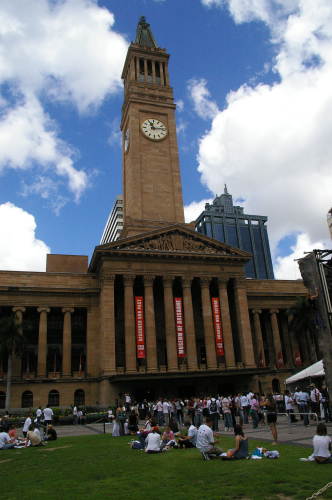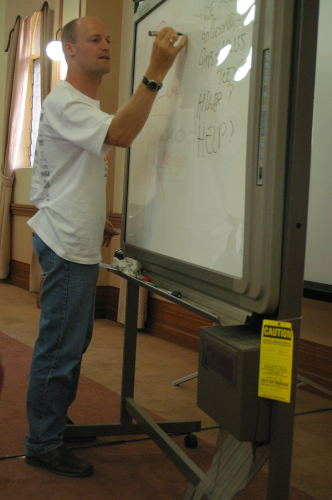Note from the National Enquirer - I wanted this to go on our Climate Action Brisbane blog but that is the "old" blogger and no longer seems to be available (or at the moment atleast). I'll need to get the admin to convert that to the new blogger.
Dec 27 2006
By Rachel Grocott, Special Correspondent
Article from Birmingham Post (Business).
As the cost of fossil fuels continues to soar, stocks continue to deplete, and damage to the environment persists, the issue of developing a sustainable fuel resource remains at the top of the environmental agenda.
The combustion of fossil fuels is the biggest contributing factor to the growing threat of climate change and sustainable fuel is needed to alleviate the pressure.
Temperatures in central England have risen by one degree Celsius since 1960. Although it could be argued that climate change has been a natural and frequently occurring phenomenon over the history of Earth, scientists and politicians largely agree that releasing harmful 'greenhouse gases' traps heat within the atmosphere and therefore causes global warming.
Man-made greenhouse gases pose a greater threat to the environment due to the huge increase in their production since the Industrial Revolution.
The gases considered most dangerous, and those that could be reduced by changing the ways in which people source their energy, are carbon dioxide, methane and nitrous oxide which have increased respectively by 31 per cent, 150 per cent and 16 per cent since mid-18th century.
Media & Marketing | E-Business | John Bright | Nevill Boyd Maunsell
Manufacturing | Legal & Finance | On the move | Enterprise
Looking at fresh ways to power the future
Dec 27 2006
By Rachel Grocott, Special Correspondent
As the cost of fossil fuels continues to soar, stocks continue to deplete, and damage to the environment persists, the issue of developing a sustainable fuel resource remains at the top of the environmental agenda.
The combustion of fossil fuels is the biggest contributing factor to the growing threat of climate change and sustainable fuel is needed to alleviate the pressure.
Temperatures in central England have risen by one degree Celsius since 1960. Although it could be argued that climate change has been a natural and frequently occurring phenomenon over the history of Earth, scientists and politicians largely agree that releasing harmful 'greenhouse gases' traps heat within the atmosphere and therefore causes global warming.
Man-made greenhouse gases pose a greater threat to the environment due to the huge increase in their production since the Industrial Revolution.
The gases considered most dangerous, and those that could be reduced by changing the ways in which people source their energy, are carbon dioxide, methane and nitrous oxide which have increased respectively by 31 per cent, 150 per cent and 16 per cent since mid-18th century.
Story continues Continue story
ADVERTISEMENT
Carbon dioxide is the result of burning fossil fuels to produce electricity and during fuel consumption for transport.
International targets to reduce levels of carbon dioxide by a third by 2020 and half by 2050 have been set. However there are parties that want to see changes take place more rapidly.
A recent plea from Friends of the Earth, backed by 34 of the Midlands' MPs from all political parties, for the Government to take action within four years to reverse global warming demonstrates the urgency of looking at alternate energy options.
The necessity to develop alternate fuel is becoming widely accepted and implemented into international, European and national law and is in the long term interests of energy companies who will stand to benefit by investing in sustainable energy forms.
In a survey, nearly 30 per cent of the world's top companies did not comment on the impact of climate change-related issues on their business.
This ignorance is likely to become unacceptable given that that 95 per cent of voters in a recent poll agreed that the Government needs to legislate to force organisations to reduce their carbon footprint.
The British economy is dependent on fossil fuels. For those who dismiss the environmental factors as the need to change energy sources, the fact that these are non-renewable resources that will exhaust one day cannot be over-looked for long.
By 2050 a world is envisaged where people fill up their cars with electricity, biofuels or hydrogen from multi-fuel stations and where hydrogen fuel cells are routinely used to provide heat and power in homes.
Vehicle emissions are second only in emitting harmful carbon dioxide output to the energy industry itself, accounting for 25 per cent of emissions.
With some alternative fuels becoming cheaper than petrol and diesel, and with tax incentives to use these alternatives, converting to environmentally sustainable fuels really can be a viable undertaking.
Other popular sustainable alternatives to petrol include:
- Ethanol, methanol and butanol, which are all sourced from fermented plant matter.
- Liquid Petroleum Gas (or LPG) is a naturally derived heavy gas produced from petroleum during processing and stored as a liquid.
- Compressed Natural Gas (or CNG) is similar to LPG n Biofuel or biodiesel is made from oil extracts sourced directly from vegetables and plants, or from recycled household vegetable oil.
The electricity consumption in the average EU household has been increasing at about two per year for the past few years.
Although significant improvements in energy efficiency have been achieved in home appliances and lighting 90 per cent rely on fossil fuels for their power.
Solar energy is an example of a sustainable fuel that could be put to use in the UK.
A number of companies and new developments are converting to solar power. Solar energy is immediately replaceable, with no direct damage to the environment as it utilises rather than depletes the sun's energy.
Solar power is progressing rapidly.
Birmingham is already showing efforts to adapt to sustainable fuel.
In 2005 Birmingham City Council received an award from the Ashden Trust for installing solar panels at the Alexander Stadium. At the time, it was the largest array of solar panels in Britain.
A partnership between the city, Worcester-based npower and Solarcentury enabled the energy saving system to be implemented. Solar energy provides electricity for the stadium and sports centre as well as selling excess to the national grid.
Matt Brown, deputy facility manager at the Alexander Stadium, said: "The slanted roof captures low angle sunlight, particularly valuable during winter months.
"The facility produces enough electricity to power 26 three bedroom homes every year. The emission savings of this revolutionary power supply equate to preventing 79,883kg of carbon dioxide to date entering our atmosphere. It would take 60 trees 100 years to absorb this much carbon. "
The UK's geographical position makes it one of the best locations for utilising renewable energy. The first wind farm was established in November 1991.
By March 2004 there were 1,043 wind turbines in operation at 84 sites around the UK, providing 649.4 MW or 0.3-0.4 per cent of the UK's electricity supply.
There are also two offshore wind farms at Blyth Offshore (4MW) and North Hoyle (60 MW). A massive one is also planned for the Thames Estuary.
They were very expensive when they were first introduced but initial costs have fallen considerably, making it a more affordable option.
The British Wind Energy Association points out that there is now primary legislation to ensure that ten per cent of our renewable energy - three per cent of our electricity - will come from wind power by 2010 and 15 per cent by 2015.
Wind has the potential to supply a third of the world's electricity by 2050, according to a report by umbrella group the Global Wind Energy Council and Greenpeace International.
The report concludes that the development of wind power is key in the fight against dangerous climate change.
It offers a blueprint for wind to supply 16.5 per cent of global electricity by 2020 - saving 1.5 billion tonnes of carbon dioxide emissions - and 34 per cent by 2050.
Sven Teske, energy expert at Greenpeace International said: "The required carbon dioxide reduction can only be achieved if wind power plays a major role in the power sector."
Attention is also turning back to coal because of its widespread availability and stable price. But the industry has had to clean up its act in recent years.
Politicians and industry experts hope the development of 'clean coal technology' will make the fuel environmentally acceptable.
New technologies are under development towards a zero emissions future.
The technological progression within the coal industry to ensure the environmental challenge is met works around three core elements:
- Eliminating emissions of pollutants such as particulates, oxides of sulphur and nitrogen
- Increasing thermal efficiency to reduce carbon dioxide and other emissions
- Eliminating carbon dioxide emissions
Coal also has the potential to produce an essential source of hydrogen for completely clean future energy systems including transport.
Currently accounting for just 0.43 per cent of the UK's energy, biomass is seen as one route to meeting targets for the reductions of carbon dioxide emissions and increased use of renewable energy.
Biomass is any plant material which can be used as a fuel, such as energy crops, wood, agricultural waste and vegetable oils. It can be burned directly to generate power, or treated to create gas or oils to be used as fuel.
An environmental project in Stafford, has produced the first crop of miscanthus - a perennial grass - harvested to provide fuel for the UK's first bio-energy plant.
Bob Talbott, founder and company chairman, said: "We have been heavily involved with the design of a two and a half megawatt generator which will utilise the miscanthus crops and eventually provide enough electricity to power around two thousand local homes."
The use of miscanthus will save carbon dioxide emissions and the plant's residue, in the form of ash, will be used as fertiliser by farms to promote miscanthus growth.
A number of businesses have already adopted a sustainable energy 'green' workplace including Innocent, a company derived on a solely 'green' basis.
It was founded in 1998 with a mission to provide healthy drinks in a sustainable fashion and the use of recycled plastic in bottles - having electricity supplied by sustainable power is helping them to achieve this goal.
Richard Reed, co-founder, said: "We've always run Innocent on green electricity, it's important to us to make Innocent drinks a truly sustainable company. We also really like the way that Good Energy works. They're independent and ethical and the way they treat their customers, suppliers and environment is really important to them."



